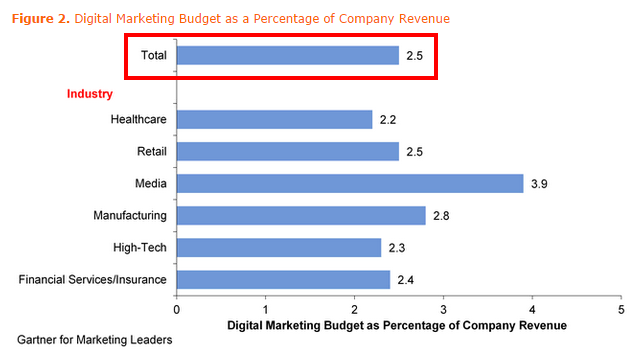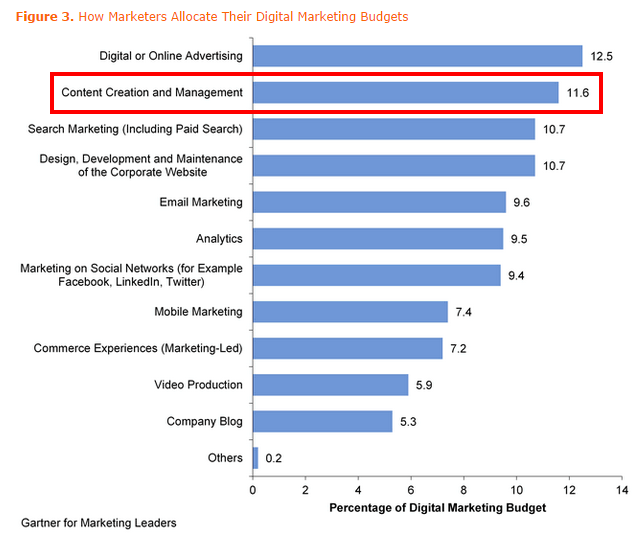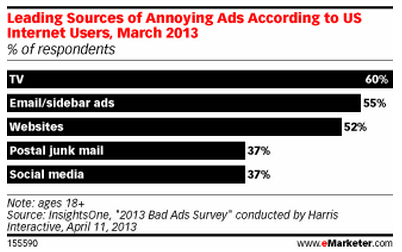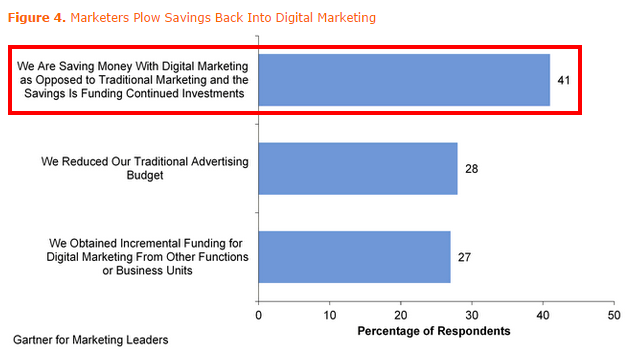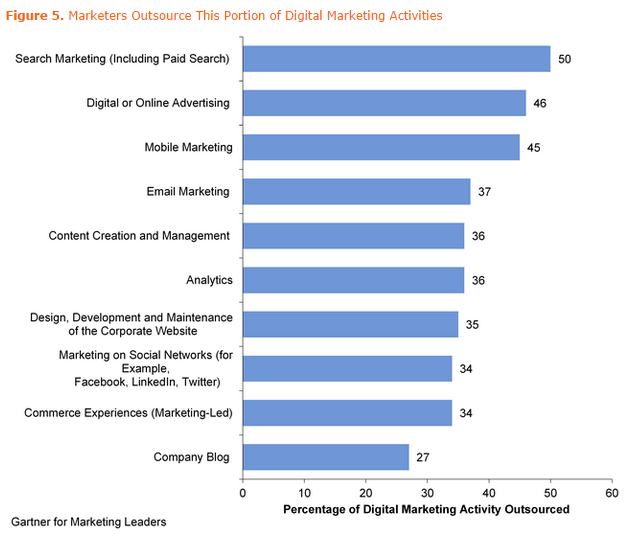I have a confession to make. I’m a little bit of a data geek. I love numbers, and I love things like benchmarking and key performance indicators. As a business owner, I’m especially interested in knowing what data can tell me about marketing best practices so that I can set the right bar for my company and provide good advice for my clients.
One question I get all of the time is “how much should I invest in digital marketing?”
As with most questions of this nature, there is no one right answer. It really depends on your company, your objectives, and your budget. Having said this, there is some really good data (did I mention how much I love data?) and a few “best practices” that I can share with you.
DIGITAL MARKETING BUDGETS ARE ON THE RISE
Digital marketing is, quite simply, any form of marketing that relies on electronic media. This includes your website, social media, email, pay per click advertising, apps, mobile marketing, etc.
The folks at Gartner have done a number of surveys to measure what companies are spending on digital marketing and their results indicate that digital marketing budgets total about 2.5% of annual revenues. These expenses include personnel costs, contract labor, software as a service and external marketing services such as agency creative services, search, website design, content creation and management, social and mobile marketing.
As you can see from the chart above, spending does vary by industry, with the healthcare sector spending the least as a percentage of revenue, and media psending the most.
Using the Gartner numbers as a guide, you can come up with some rough numbers to build a budget for your company. As an example, If you’re a $ 1 million company, you should plan to budget around $ 25,000 a year on digital marketing.
DIGITAL REPRESENTS AN INCREASING SHARE OF THE OVERALL MARKETING MIX
In addition to this data on digital marketing, Gartner also looked at overall marketing budgets (including both digital and traditional, offline marketing). They found that marketers were spending a total of 10.4% of their annual revenues on marketing in general, with digital marketing accounting for the aforementioned 2.5%. Interestingly, digital’s share of the overall marketing budget is on the rise, and expected to increase by 9% this year.This is growing at a higher rate than overall spending on marketing, which is expected to increase by just 6%.
Digital’s growing piece of the marketing pie is a reflection of a major shift in consumer buying habits and spending, and the resulting increasing importance companies are placing on the online realm, both in terms of its ability to generate results AND in terms of its cost effectiveness.
DIGITAL ADVERTISING AND CONTENT CREATION ACCOUNT FOR THE LARGEST SHARE OF DIGITAL MARKETING BUDGETS
As marketing has moved online, the way companies market themselves has evolved. Advertising still represents the largest share – at 12.5% – of the overall digital marketing budget, but content creation and management (11.6% of budgets) is quickly catching up and expected to overtake spending on digital advertising in the near future.
The emphasis on great content is a reaction to the increasing skepticism of online audiences and their dislike of being “sold to.” Last year, consumer predictive intelligence firm InsightsOne carried out a survey and found that the vast majority of US adults are becoming increasingly annoyed by advertising, both online and offline.
Whether they are investing in inbound or outbound marketing, companies have recognized that the most effective way to engage with their audience is to provide them with helpful information that solves their problems or answers their questions. This information (online content) can take many forms, from ebooks and whitepapers, to videos, infographics, webinars and more.
COMPANIES ARE BUDGETING FOR MARKETING SOFTWARE AND HARDWARE
In addition to their marketing budgets, the majority (two thirds) of companies have a capital budget for the purchase of marketing software and hardware. This is funded in part from the savings companies are realizing from their digital marketing efforts.
What types of investments are being funded through capital budgets? In addition to hardware such as servers, storage, and computers, many companies are investing in marketing software in order to better harness the power of big data for driving marketing insights. The shift is so big that Gartner Group has been quoted as saying that “By 2017, a CMO will spend more on IT than the CIO.”
Ajay Agarwal of Bain Capital Partners summed up the factors driving this shift really well in an article for emerging tech website Gigaom, saying:
- A web business can mine thousands of signals from its prospects based on the hundreds of actions a consumer might make on a website (checking a price, looking at an image, reading a review, typing in a detailed search query, etc.).
- The holy grail of closed loop marketing is finally here. With sophisticated technology and analytics, marketers can link spending on customer acquisition directly to a set of downstream customer actions — whether those actions take place on the web, on a mobile device or in a physical location.
- Consumers with smartphones are conveying their intent while scanning QR codes, downloading mobile coupons or simply walking into a store with their location-aware device.
- Social networks are providing a new source of demographic data that, combined with Facebook’s Open Graph, offer marketers a new treasure trove of information.
These developments have driven strong demand for software-as-a-service platforms such as HubSpot, Marketo,Eloqua, and more.
UP TO HALF OF ALL DIGITAL MARKETING ACTIVITIES ARE OUTSOURCED
Because the world of marketing is evolving so rapidly, many companies have had a hard time keeping pace and, as a result, have outsourced their digital marketing efforts to specialized providers. The concept of outsourced marketing is nothing new – companies have been working with ad agencies for years. The difference now is the widening breadth of activities that are being outsourced, from social media and blogging, to content creation, analytics, email marketing, and online advertising.
There are three reasons to outsource your digital marketing:
- You lack the right in-house expertise: Digital marketing is constantly evolving, with new technologies, emerging social media platforms, and adjustments to search engine algorithms. Staying current is practically a full time job and many companies don’t have the bandwidth to do this with existing staff.
- You prefer to focus on your core business: This really comes down to a business management decision, with many executives preferring to focus their in-house staff on their business (be it manufacturing, IT, retail, consulting, etc.) rather than on marketing.
- You can save money: For smaller companies in particular, outsourcing can make good financial sense. Digital marketing requires a diverse skill set encompassing web design, graphic design, SEO, copywriting, strategy and more. Hiring a team with these skills can be expensive, whereas hiring a marketing company can provide you with all of these skills for a low, fixed monthly fee (and no need to pay benefits or incur overhead).
The key to outsourcing is to take the time up front to set expectations, establish clear goals, and have a plan in place to measure progress against those goals.
WHAT IT ALL MEANS FOR YOU
If, like me, you love data, a good first step in evaluating your own marketing is to tally what you are spending (and remember, spending includes personnel costs, contract labor, software as a service and external marketing services such as agency creative services, search, website design, content creation and management, social and mobile marketing). Once you’ve got this number, its time to determine what percentage of your overall annual revenues this represents, with the “best practice” benchmark somewhere around 2.5%.
In addition, its worth looking at what portion of this spending you’re putting into content creation and management. Do you have a blog? Are you producing helpful content that is educational in nature? How are you promoting it? Having a strong content strategy is increasingly the key to online lead generation. Managing your content strategyis also important, and this is where an investment in marketing automation can have a big impact.
Finally, if you’re feeling overwhelmed, it may be time to outsource your marketing to a specialized partner. I’m a little biased, because that’s what we do, but I’ve seen this model work really well for a wide variety of companies across a range of industries. The accountability that comes with an outsourcing arrangement is a great way to make sure that your marketing work gets done on time and under budget.
How much is YOUR company spending on marketing? And do you outsource any of it? We’d love to know your thoughts – share them with us in the comments!
Business Articles | Business 2 Community
(611)

